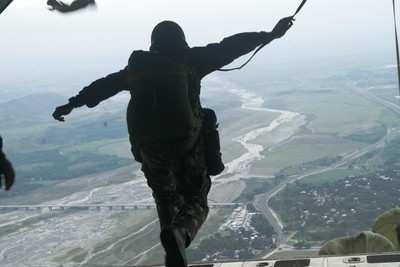 Republic of the Philippines Air Force members,
together with the 710th Special Operations Wing and U.S.
Marines with Amphibious Reconnaissance Platoon and Deep
Reconnaissance Platoon, 31st Marine Expeditionary Unit, came
together to fly thousands of feet above the ground at Drop Zone
Expo, April 20-23, in support of Balikatan 2009.
Republic of the Philippines Air Force members,
together with the 710th Special Operations Wing and U.S.
Marines with Amphibious Reconnaissance Platoon and Deep
Reconnaissance Platoon, 31st Marine Expeditionary Unit, came
together to fly thousands of feet above the ground at Drop Zone
Expo, April 20-23, in support of Balikatan 2009.
The Philippine airmen conducted airborne sustainment training,
while the U.S. Marines participated in the Multi-Mission Parachute
Double Bag Transition Course. Both nations executed jumps from
1,250 feet above ground level; however the Marines participating in
course also jumped from 6,000 feet.
According to Gunnery Sgt. Timothy A. Parkhurst, the paraloft
chief and parachute safety officer for 3rd Reconnaissance
Battalion, the course encompasses the new Multi-Mission Parachute
System (MMPS). The system, which is Marine Corps specific, adds
capabilities by allowing units to jump from altitudes as high as
25,000 feet, which in turn creates a stealthier means of
insert.
“When jumping from higher altitudes you have more time to
reach your destination, said Parkhurst, an Overland Park, Kan.,
native. “This allows the Marines to jump at locations as far
as 30 to 50 kilometers from their target which helps make them more
undetectable.”
Cpl. Josh Riley, a reconnaissance man with ARP, said the canopy
in the new MMPS opens slower, giving the jumper a smoother ride and
adding more opportunity for mid-air course changes.
The goal set by the two nations’ jump teams was to execute
10 jumps throughout the period, completing three a day if weather
permitted. Airspace access in the Republic of the Philippines and
prevailing winds more readily allows for parachute training than in
Okinawa, Japan.
“There is a lot to factor in when doing jumps in Okinawa;
such as getting airspace,” said Parhurst, a 16-year
veteran.
Because of this, the RPAF hosts 3rd Recon Bn. on two other
occasions throughout the year, allowing the PAF airmen and U.S.
Marines to work together frequently and form strong bonds and
friendships.
“It’s not like other exercises where you go once a
year and you might not see those people ever again,”
Parkhurst said. “We see many of the same guys over and over,
so we can form long-lasting friendships and are excited to come
back and see each other as often as we do.”

Tech. Sgt. Jerry Feliciano, a jumpmaster with 710 SPOW, said
even though the two services jump separately, they can watch and
learn from each other.
“They go and then we go, so we learn more talking back in
the hangar than we do on the aircraft.” Riley echoed
Feliciano saying the counterparts’ ability to share those
experiences and stories is crucial from a team building aspect as
well. “The fact that we are all jumpers just adds to our
similarities and that helps strengthen the bond between us and our
nations,” he said.
The Multi-Mission Parachute Double Bag Transition Course and
airborne sustainment training took place in support of Balikatan
2009. Bilateral training and security assistance programs executed
during Balikatan ’09 by Republic of the Philippines military
and the U.S. Armed Forces, increase their ability to work together
effectively to provide relief and assistance in the event of
natural disasters and other crises that affect public health and
safety. [ANN Salutes Lance Cpl. Michael A. Bianco, 31st MEU, for
the story.]
 NTSB Prelim: Hy-Tek Hurricane HP
NTSB Prelim: Hy-Tek Hurricane HP ANN's Daily Aero-Term (05.14.25): Flight Check
ANN's Daily Aero-Term (05.14.25): Flight Check Aero-News: Quote of the Day (05.14.25)
Aero-News: Quote of the Day (05.14.25) ANN's Daily Aero-Term (05.15.25): Primary Radar
ANN's Daily Aero-Term (05.15.25): Primary Radar Airborne 05.12.25: $1M Flying Car, Marion Airport Saved, AirVenture Cup
Airborne 05.12.25: $1M Flying Car, Marion Airport Saved, AirVenture Cup




